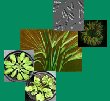| Beck, E; Scheibe, R; Senser, M: The vegetation of the Shira Plateau and the Western slopes of Kibo (Mt. Kilimanjaro, Tanzania), Phytocoenologia, 11, 1-30 (1983), doi:10.1127/phyto/11/1983/1 | |
| Abstract: Vegetation analysis of the Ericaceous and the Alpine belt was performed on the West-slope of Mt. Kilimanjaro (Tanzania) i.e. in an altitudinal range from about 11,000 ft. up to the summit of the mountain (19,340 ft.). The studied area comprised the Shira Mountains, the Shira Plateau and the western slope of Kibo. A short analysis of the relevant ecological features of the area is provided. Nine vegetation formations and ten plant communities could be abstracted subsequent to analysis of about 50 plots. The most widespread communities of the Ericaceous belt are the Philippia trimera-Blaeria johnstonii-community, characteristic of the vegetation formation Ericaceous Bush and the Deschampsia caespitosa-Carex monistachyay-community prevailing in the Tussock moorland. Dominating smaller localities, two communities of an Alchemilla-Scrub (one of these is characterized by the spectacular Dendrosenecios and giant Lobelias), one each of the Helichrysum-Scrub and of a Tussock grassland and the so-called Gorge vegetation complete the picture of the vegetation formations of the Ericaceous belt. The latter type, due to permanent moisture, encompasses nearly all species of the region. The western foothills of Kibo are predominantly occupied by a mixed vegetation which contains elements of the Ericaceous Bush, the Helichrysum- and the Alchemilla-Scrub. This mixed type peters out versus the Alpine desert with a Helichrysum citrispinum-Senecio telekii- community. The latter as well as the Alpine desert are characteristic of the Alpine belt of Mt. Kilimanjaro. The headwater areas in the Alpine belt are covered by grassland communities. That found in the wet areas is dominated by Colpodium chionogeiton whereas tussocks formed by various species are characteristic of adjacent drier habitats. Due to large fires and poor visibility, mapping of the various plant communities could only be achieved for those areas visited by foot or vehicle. |

Letzte Änderung 24.06.2020

